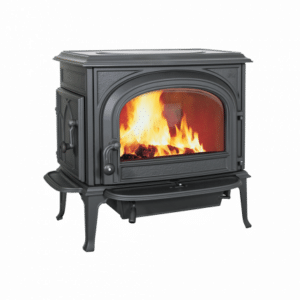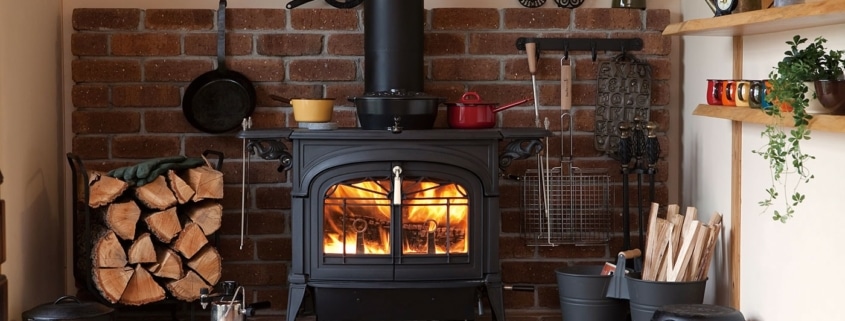What Is a Wood Stove?
There’s something about the warmth, coziness, and crackling of a wood fire that just can’t be beat. Fortunately, if you’ve been dreaming to install a wood-burning fireplace in your home, there are many options to choose from — one being a wood stove.
Below, we’ll give an overview of what a wood stove is, how it works, why it’s a great choice, and where to get started in your search for one.
What Is a Wood Stove?
Let’s start with a definition. A wood stove is a type of heating appliance that generates heat by burning wood fuel, or some type of wood-dervied biomass fuel (e.g. wood pellets or sawdust bricks).
For reference, here’s an photo of a wood stove from one of our manufacturers, Jøtul®.

Photo courtesy of Jøtul® — Model: F 500 V3 Oslo CF.
The Difference Between a Wood Stove and a Traditional Wood-Burning Fireplace
Important tip: a wood stove is not the same as a traditional wood-burning fireplace. Although they both use wood or wood-derived products as fuel, there are key differences between the two.
The biggest difference has to do with construction. A traditional fireplace is a structure that’s typically built into a wall and made of block, firebrick, clay flues, etc. There are also some decorative and high-efficiency fireplaces made of steel.
A wood stove is a standalone device consisting of three prefabricated components: a firebox, a vent pipe, and a chimney. It isn’t built into a wall, and it can be made of materials like steel, cast iron, or soapstone.
This difference in construction affects various other characteristics of a wood stove (appearance, performance, efficiency, etc.), which we’ll discuss more below.
How Does a Wood Stove Work?
There’s a unique science to how a wood stove works. The most important factors are maintaining steady airflow through the stove’s vents and creating a controlled environment where wood can burn efficiently. When you think about the fire triangle — fuel source, heat (spark), and oxygen — wood stove do a particularly good job with the oxygen component.
Here’s a closer, step-by-step look at the process:
- You put wood inside of the stove’s firebox.
- You light the stove with a spark, and the fire is contained with the stove’s fireproof walls.
- Air is pulled in through the stove’s air vents and dampers, which control the amount of airflow that reaches the firebox. This allows the wood to burn slowly and efficiently.
- Exhaust fumes are drawn up through the stove’s chimney and exit the home/building.
Where Can a Wood Stove Be Installed?
Wood stoves can be installed in any new construction or renovation project. One of their benefits is that they make installation a relatively easy task, compared to other types of fireplaces and heating appliances. Their prefabricated chimney pipes enable them to be installed just about anywhere you’d like.
However, there are a few important things to keep in mind when choosing your ideal wood stove placement, including:
- Level of warmth — You’ll want to put your wood stove as close as possible to the center of the area you’d like heated.
- Efficiency — Try to avoid placing your wood stove near any exterior walls. The closer proximity to cooler outdoor temperatures can make your stove work significantly harder.
- Space for firewood — Make sure you have plenty of room surrounding your stove to keep firewood nearby.
- Flooring protection — Wood stoves have fireproof boxes, but the occasional spark may fall out while you’re kindling. Install fire-resistant flooring or a hearth pad.
- Wall protection — Same goes for your walls. They’ll experience some serious heat coming from your stove, so it’s important to have materials that can withstand it.
Top 5 Benefits of Wood Stoves
Wood stoves offer many benefits — regardless if they’re installed in a home, office, or other type of building. Here are five of the primary advantages you’ll enjoy if you choose one.
1. Long-Term Affordability
Wood stoves are known for their cost-effectiveness. When you consider the relatively low cost of firewood and the high level of efficiency offered, it’s difficult to find a heating appliance that’s more affordable in the long run.
2. Consistent Fuel Supply
We’ve recently experienced a lot of uncertainty when it’s come to things like inflation, rising gas prices, and supply chain shortages. With a wood stove, you’ll have one less thing to worry about. You can always have peace of mind that firewood will always be available and relatively affordable, even when gas and other fuel sources may not be.
3. Unmatched Efficiency
Wood stoves are significantly more efficient at converting wood to heat than traditional wood-burning fireplaces. According to the United States Environmental Protection Agency (EPA), wood stoves have an average efficiency of around 70%. This means they’re capable of converting about 70% of wood’s organic matter into heat. When you compare that to a traditional fireplace’s average efficiency of about 25%, the efficiency is indisputable.
EPA-certified wood stoves also produce fewer than 2.5 grams or less of smoke per hour, which is incredibly low. Older, uncertified stoves and traditional fireplaces release much more smoke into the environment — at levels of 15-30 grams or more per hour.
There’s also a new tax credit under Section 25(C) of the Internal Revenue Code that anyone purchasing a wood stove with at least a 75% higher heating value can take advantage of. It’s a 30% credit that’s capped at $2,000 annually.
4. Installation Freedom
Due to their compact size and prefabricated components, wood stoves can be installed just about anywhere. As long as you consider the installation factors mentioned in the section above, you should be able to enjoy your wood stove to the fullest, wherever you’d like it.
5. Simple Maintenance
Traditional wood-burning fireplaces have flues, which can be quite difficult to clean and maintain. Wood stoves don’t have flues, but rather use vent pipes for this purpose. Vent pipes are much easier to clean and maintain, leaving you with less time and money spent on maintenance.
However, we do still recommend that you have your wood stove and vent pipes inspected and cleaned by a certified chimney sweep at least once per year. This will ensure your stove is functioning properly and running at top efficiency.
Our Favorite Wood Stove Brands
If you’re hoping to install a wood stove, it’s important to do your research on what brand you purchase. Here’s a list of some of the wood stove brands that we trust to deliver high-performing, highly efficient models. At VanderWall Bros., we carry models from each of these brands — along with various other brands with different heating appliance product offerings.
Interested in Installing a Wood Stove? Contact VanderWall Bros.
Wood stoves have been heating homes efficiently for years, and increased EPA regulations have only made them better. If you’re interested in installing one in your home, get in touch with our team. We carry various models from popular, trusted manufacturers, and we provide professional installation and maintenance services.



